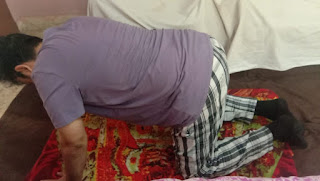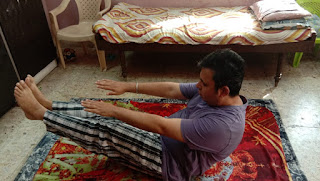Balasana or Child Pose for Stress and Anxiety
Balasana or Child Pose
 |
| Balasana or Child Pose Step 1 |
 |
| Balasana or Child Pose Step 2 |
In Sanskrit Bal means ‘Child’ and Asana means ‘Pose’. In
this asana, we have to rest like a child. So, it is named as Child Pose or
Balasana. This pose stretches hips, thighs and legs. It calms the mind and
relieves stress and tension. It is also called as Garbhasana or Shashankasana
as the body faces the floor in foetal position.
Balasana or Child Pose is a resting pose. It is a forward
bending pose. It can be sequenced between more challenging asanas.
Benefits of Balasana or Child Pose
·
It stretches gently lower back, hips, thighs,
knees and ankles.
·
It relaxes spine, shoulders and neck.
·
It increases blood circulation to our head which
may soothe headaches.
·
It stimulates digestion and elimination.
·
It helps ease neck and back pain.
·
It is a great pose to ease anxiety and stress.
·
It is excellent pose for rejuvenating central
nervous system. It relaxes all the muscles surrounding the vertebrae of the
spine.
How to do Balasana or Child Pose
1.
Take Yoga mat. Come in a tabletop position on
your hands and knees.
2.
Try to widen your knees such that they are wider
than your hips. Try to touch big toes of both feet.
3.
Slowly lower hips towards heels and sit on it. If
you are not comfortable, place a cushion in between your hips and heels for
support. A cushion or rolled up towel can be kept under ankles for beginners. Later,
after enough practice, support can be removed.
4.
Try to rest your forehead on the floor. If you
cannot then place your fist or cushion beneath and then rest your forehead on
it. Hand will remain comfortably stretched besides head.
5.
Gently press your chest on thighs or in between
thighs, if they are apart.
6.
Hold the position for 30-45 seconds or as long you
are comfortable.
7.
Slowly and gradually walk your hands back,
lifting your upper body. Come back to original position sitting on heels. Keep hands
on thighs.
Contraindications
·
Pregnant Women, People suffering from diarrhoea,
Having Knee Injury should not perform this asana.
·
People with high or low blood pressure should do
this asana with caution.
·
Ensure that the stomach and bowels are empty for
this pose otherwise discomfort might be experienced.



Comments
Post a Comment